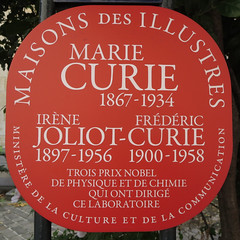Marie Curie


Marie Curie
(1867-1934)
woman, discoverer of radium, chemist, Nobel Physics Laureate (from 1903), and Nobel Chemistry Laureate (from 1911)
Family tree
Commemorated on 7 plaques
En 1898 dans un laboratoire de cette école Pierre et Marie Curie assistés de Gustave Bemont ont découvert le Radium
English translation: In 1898 in a laboratory of this school Pierre and Marie Curie assisted by Gustave Bemont discovered the Radium [AWS Translate]
10 rue Vauquelin, Paris, France where they was
Ici se trouvait le laboratoire dans lequel Pierre et Marie Curie ont decouvert le Radium 1898-1902
English translation: Here was the laboratory in which Pierre and Marie Curie discovered the Radium 1898-1902 [AWS Translate]
rue Pierre Brossolette, Paris, France where they discovered radium (1898-1902)
Marie Curie 1867 - 1934 a habité cet immeuble de 1912 à 1934
English translation: Marie Curie 1867 - 1934 inhabited this building from 1912 to 1934 [AWS Translate]
36 Quai de Béthune, Paris, France where they lived (1912-1934)
En 1898 Pierre et Marie Curie habitaient cet immeuble lorsqu'ils découvrirent le Radium a l'École supérieure de physique et de chimie de Paris
English translation: In 1898 Pierre and Marie Curie lived in this building when they discovered the Radium at the Higher School of Physics and Chemistry of Paris
24 rue de la Glacière, Paris, France where they lived (1898)
Marie Curie (1867-1934), Irène Joliot-Curie (1897-1956), Frédéric Joliot-Curie (1900-1958): trois Prix Nobel de Physique et de Chimie, qui ont dirigé ce laboratoire.
English translation: Marie Curie (1867-1934), Irène Joliot-Curie (1897-1956), Frédéric Joliot-Curie (1900-1958): three Nobel Prize winners in Physics and Chemistry, who led this laboratory. [AWS Translate]
1 rue Pierre et Marie Curie, Paris, France where they was
Dans cet amphithéâtre, le 5 novembre 1906, Marie Curie première femme professeur à la Sorbonne, donna son premiers cours
English translation: In this amphitheatre, on 5 November 1906, Marie Curie, the first woman professor at the Sorbonne, gave her first lecture
47 Rue des Ecoles, Paris, France where they lectured (1906)
Marie Curie 1867-1934 première femme prix Nobel a vécu ici en 1891.
English translation: Marie Curie 1867-1934 first woman Nobel Prize lived here in 1891. [AWS Translate]
92 avenue Jean-Jaurès, Paris, France where they lived (1891)







